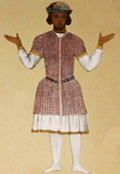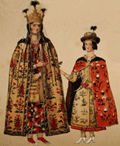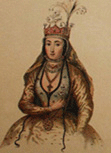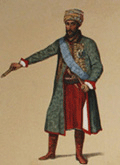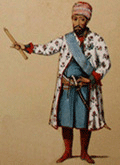Georgian Literary Tradition
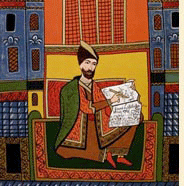 Georgian language belongs to the Kartvelian group of the Caucasian Language Family. From this family, Georgian is the only language that has an old alphabet and literary tradition. Oldest texts that have survived in the Georgian language date from the second half of the 4th century A.D. According to Greek chronicles, Georgian was spoken in Colchis and Caucasian Iberia in ancient times.
Georgian language belongs to the Kartvelian group of the Caucasian Language Family. From this family, Georgian is the only language that has an old alphabet and literary tradition. Oldest texts that have survived in the Georgian language date from the second half of the 4th century A.D. According to Greek chronicles, Georgian was spoken in Colchis and Caucasian Iberia in ancient times.
Ancient Georgian literature is an important part of the Eastern Orthodox Christianity. The earliest period of the Georgian literature -- 5th-8th centuries -- is rich in hymnography and hagiographic works. Georgian historical chronicles have great importance for studying the history and cultures of the Caucasian highlanders. They are also important for the study of Transcaucasia (Georgia, Azerbaijan and Armenia), and the Near East. Because of its mediating position between Northern and Southern, between Western and Eastern worlds, Georgia became one of the centers of translations in the Middle Ages. Translations were conducted in Georgia (at the Academies of Phasisi -- 4th century, Gelati -- 9th-12th centuries, Iqalto -- 12th century), as well as outside of the country (at Black Mountain in Syria, Sinai Mountain in Egypt, Olympia and Athos Mountains in Greece, and Petritsoni-Bochkovo in Bulgaria). Literary works translated into Georgian add valuable information to the studies of the histories and cultures of the Near Eastern countries, as they help to reconstruct some of the original lost writings in Greek, Syriac, Persian, and Arabic.
Some of the Eastern literary works were introduced into Europe through the Georgian translations. For example, Georgian Visramiani (12th century) is the translation of Indian Ramayana, and the Wisdom of Balahvar (10th-11th centuries) is the Christian version of the story of Buddha.
After Christianity spread into Georgia (337 A.D.), religious and theological thought developed to a new level. Several original Georgian theological works are considered great achievements of the Eastern Orthodox Christian civilization; among these are the works of Dyonisus the Areopagite -- famous Georgian philosopher Peter the Iberian of the 5th century. Georgia is considered a homeland of the Eastern Renaissance (9th-12th centuries). Shota Rustaveli's philosophical-allegorical Poem "The Knight in the Panther's Skin" is the greatest work of this period.
Georgian language is characterized with extensive borrowings from various languages, with which it came in contact during the course of the history. Because of this fact, the language is very rich in vocabulary, as well as dialects. However, the grammatical structure of the language does not reflect these borrowings and does not relate to any languages of the world. Only three Kartvelian non-written languages relate to Georgian, such as Svan, Megrelian, and Laz.


